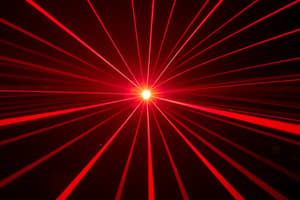Podcast
Questions and Answers
What does the acronym LASER stand for?
What does the acronym LASER stand for?
- Light Alteration by Standard Emission of Radiation
- Light Amplification by Stimulated Emission of Radiation (correct)
- Light Amplitude by Stimulated Emission of Radiation
- Light Availability by Stimulated Emission of Radiation
Which of the following is not a component of a laser system?
Which of the following is not a component of a laser system?
- Active medium or laser medium
- Optical sensor (correct)
- Energy source (pump)
- Mirrors
Which type of laser is typically made from a dye solution?
Which type of laser is typically made from a dye solution?
- Liquid laser (correct)
- Semiconductor laser
- Gas laser
- Solid-state laser
What characteristic of lasers allows them to produce high intensity?
What characteristic of lasers allows them to produce high intensity?
Which type of laser is widely known for its use of a ruby crystal as the lasing medium?
Which type of laser is widely known for its use of a ruby crystal as the lasing medium?
Gas lasers generally require which type of medium?
Gas lasers generally require which type of medium?
In terms of laser power, what does power density measure?
In terms of laser power, what does power density measure?
What is a unique feature of laser light compared to regular light?
What is a unique feature of laser light compared to regular light?
Flashcards
What does LASER stand for?
What does LASER stand for?
LASER stands for Light Amplification by Stimulated Emission of Radiation. It's a revolutionary tool used in various medical fields for diagnosis, treatment, surgery, and even medical equipment.
What is the active medium in a laser?
What is the active medium in a laser?
The active medium is the material inside the laser that gets excited by energy, leading to light amplification. Examples include ruby, neodymium-doped yttrium aluminum garnet (Nd:YAG), and gases like Helium-Neon.
What is the energy source (pump source) in a laser?
What is the energy source (pump source) in a laser?
The energy source pumps energy into the active medium, causing it to become excited and emit light. Examples include flash lamps and electrical currents.
What is the function of the optical resonator in a laser?
What is the function of the optical resonator in a laser?
Signup and view all the flashcards
What are solid-state lasers?
What are solid-state lasers?
Signup and view all the flashcards
What are gas lasers?
What are gas lasers?
Signup and view all the flashcards
What are liquid lasers?
What are liquid lasers?
Signup and view all the flashcards
What are semiconductor lasers?
What are semiconductor lasers?
Signup and view all the flashcards
Study Notes
Biophysics Tutorial (Week 7)
- The tutorial focuses on lasers
- The presentation covers lasers in medicine, including their history, components, types, and applications
Introduction to Laser and its Applications
- Lasers use Light Amplification by Stimulated Emission of Radiation (LASER)
- The acronym LASER represents the process of light amplification.
Laser in Medicine
- Lasers are used in a wide range of medical disciplines
- These include diagnosis, therapy, surgery, and medical instrumentation.
History of Laser
- The word "laser" is an acronym for light amplification by stimulated emission of radiation
- Its applications in medicine are significant
Basic Components of Laser
- Laser systems have three main parts
- Active medium (laser medium)
- Energy source (pump)
- Optical resonator (mirrors)
Laser Principles
- Spontaneous absorption – light absorption by atoms
- Spontaneous emission – light emission by excited atoms
- Stimulated emission – light emission by excited atoms upon interaction with photons
Types of Lasers
- Lasers can be categorized by their active medium
- The different types are solid-state, gas, liquid, and semiconductor.
Unique Properties of Laser Light
- Laser light is monochromatic (single wavelength)
- Laser light is coherent (with consistent phase and polarization). This creates strong intensity, a narrow and collimated ray.
- A laser ray is very powerful.
Differences between Laser and Ordinary Light
- Laser light is monochromatic, collimated, and coherent. Ordinary light is not
- The presentation uses diagrams illustrating these differences in appearance.
Laser Power and Classification
- Laser power is measured in watts or milliwatts, and power density in milliwatts per centimeter squared (mW/cm²)
- It can be classified into four groups according to their power ranges
Laser Classifications
- The classification table details the power range, and effect of each level
- Class 1 lasers pose no hazard
- Class 4 lasers can cause serious burns to skin and clothing, and injury to eyes and require extreme caution.
Types of Laser
- The different types include laser diode, gas lasers, dye lasers, and solid-state lasers.
Solid-State Laser
- A solid-state laser typically consists of a laser medium (ruby or Nd:YAG) within a flashtube
- A fully reflecting mirror, a partially reflecting mirror, and the laser output component are visible in the diagram.
Laser Medium
- The medium can be either a glass or crystalline material.
- Ruby is an example of a typical solid-state laser medium.
- Neodymium-doped yttrium aluminum garnet (Nd:YAG) is highly common.
Gas Laser
- Gas lasers use a mixture of gases (Helium-Neon, Argon, CO2) as the laser medium
- Gas lasers usually output in the IR spectrum range.
Liquid Laser
- Dye lasers are a type of liquid laser
- They utilize liquid dyes as the active medium
- They generate a light beam ranging from the near-ultraviolet (UV) to the near-infrared (IR) region.
Semiconductor (Diode) Laser
- A p-n junction in a semiconductor diode functions as the laser medium
- These lasers are very compact, cheap, and consume low power which don't need external mirrors.
- Electrical energy is used as the pump source in this type.
Studying That Suits You
Use AI to generate personalized quizzes and flashcards to suit your learning preferences.




